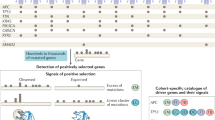Abstract
Knudson’s two-hit model of tumour suppressor genes supposes that two mutations are required to cause a tumour, one occurring in each of the two alleles of the gene. Many such cancer genes exhibiting biallelic disruption and truncating point mutations have been identified, revealing the success of the model. Despite changes in our concept of cancer genes, two inactivating point mutations are still considered the hallmark of tumour suppressor genes. Recently, however, more and more reports describe candidate tumour suppressors that do not conform to this standard definition, including haploinsufficient genes requiring inactivation of only one allele, and genes inactivated not by mutation but rather epigenetic hypermethylation. This review describes some of these exceptions and proposes a revised tumour suppressor gene definition to facilitate the identification of this new generation of tumour suppressor loci.
Similar content being viewed by others
Author information
Authors and Affiliations
Corresponding author
Additional information
Received 21 January 2003; received after revision 26 March 2003; accepted 1 April 2003
Rights and permissions
About this article
Cite this article
Paige, A.J.W. Redefining tumour suppressor genes: exceptions to the two-hit hypothesis. CMLS, Cell. Mol. Life Sci. 60, 2147–2163 (2003). https://doi.org/10.1007/s00018-003-3027-6
Issue Date:
DOI: https://doi.org/10.1007/s00018-003-3027-6




